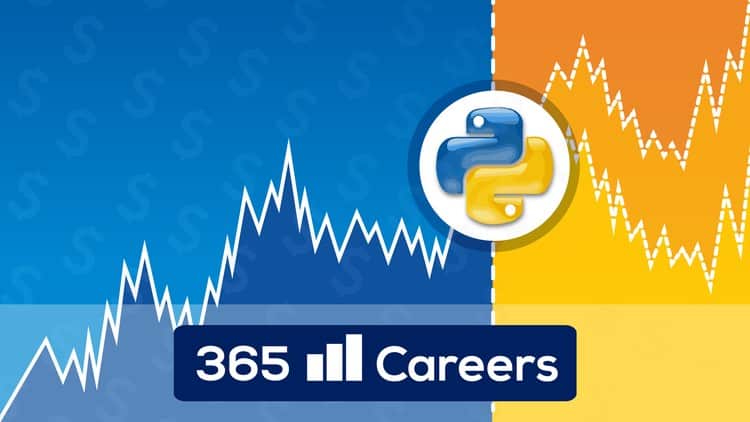Time Series Analysis in Python 2020
Time Series Analysis in Python: Theory, Modeling: AR to SARIMAX, Vector Models, GARCH, Auto ARIMA, Forecasting
- Differentiate between time series data and cross-sectional data.
- Understand the fundamental assumptions of time series data and how to take advantage of them.
- Transforming a data set into a time-series.
- Start coding in Python and learn how to use it for statistical analysis.
- Carry out time-series analysis in Python and interpreting the results, based on the data in question.
- Examine the crucial differences between related series like prices and returns.
- Comprehend the need to normalize data when comparing different time series.
- Encounter special types of time series like White Noise and Random Walks.
- Learn about “autocorrelation” and how to account for it.
- Learn about accounting for “unexpected shocks” via moving averages.
- Discuss model selection in time series and the role residuals play in it.
- Comprehend stationarity and how to test for its existence.
- Acknowledge the notion of integration and understand when, why and how to properly use it.
- Realize the importance of volatility and how we can measure it.
- Forecast the future based on patterns observed in the past.
- No prior experience with time-series is required.
- You’ll need to install Anaconda. We will show you how to do that step by step.
- Some general understanding of coding languages is preferred, but not required.
Description
How does a commercial bank forecast the expected performance of their loan portfolio?
Or how does an investment manager estimate a stock portfolio’s risk?
Which are the quantitative methods used to predict real-estate properties?
If there is some time dependency, then you know it – the answer is: time series analysis.
This course will teach you the practical skills that would allow you to land a job as a quantitative finance analyst, a data analyst or a data scientist.
In no time, you will acquire the fundamental skills that will enable you to perform complicated time series analysis directly applicable in practice. We have created a time series course that is not only timeless but also:
· Easy to understand
· Comprehensive
· Practical
· To the point
· Packed with plenty of exercises and resources
But we know that may not be enough.
We take the most prominent tools and implement them through Python – the most popular programming language right now. With that in mind…
Welcome to Time Series Analysis in Python!
The big question in taking an online course is what to expect. And we’ve made sure that you are provided with everything you need to become proficient in time series analysis.
We start by exploring the fundamental time series theory to help you understand the modeling that comes afterwards.
Then throughout the course, we will work with a number of Python libraries, providing you with a complete training. We will use the powerful time series functionality built into pandas, as well as other fundamental libraries such as NumPy, matplotlib, StatsModels, yfinance, ARCH and pmdarima.
With these tools we will master the most widely used models out there:
· AR (autoregressive model)
· MA (moving-average model)
· ARMA (autoregressive-moving-average model)
· ARIMA (autoregressive integrated moving average model)
· ARIMAX (autoregressive integrated moving average model with exogenous variables)
. SARIA (seasonal autoregressive moving average model)
. SARIMA (seasonal autoregressive integrated moving average model)
. SARIMAX (seasonal autoregressive integrated moving average model with exogenous variables)
· ARCH (autoregressive conditional heteroscedasticity model)
· GARCH (generalized autoregressive conditional heteroscedasticity model)
. VARMA (vector autoregressive moving average model)
We know that time series is one of those topics that always leaves some doubts.
Until now.
This course is exactly what you need to comprehend time series once and for all. Not only that, but you will also get a ton of additional materials – notebooks files, course notes, quiz questions, and many, many exercises – everything is included.
What you get?
· Active Q&A support
· Supplementary materials – notebook files, course notes, quiz questions, exercises
· All the knowledge to get a job with time series analysis
· A community of data science enthusiasts
· A certificate of completion
· Access to future updates
· Solve real-life business cases that will get you the job
We are happy to offer a 30-day money back in full guarantee. No risk for you. The content of the course is excellent, and this is a no-brainer for us, as we are certain you will love it.
Why wait? Every day is a missed opportunity.
Click the “Buy Now” button and start mastering time series in Python today.
- Aspiring data scientists.
- Programming beginners.
- People interested in quantitative finance.
- Programmers who want to specialize in finance.
- Finance graduates and professionals who need to better apply their knowledge in Python.
Created by 365 Careers
Last updated 1/2020
English
English [Auto-generated]
Size: 2.92 GB
